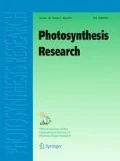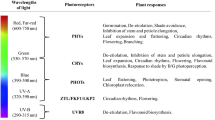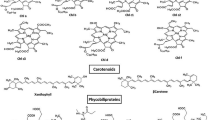Abstract
The quenching of variable fluorescence yield (qN) and the quenching of dark level fluorescence yield (q0) directly atributable to high-energy-state fluorescence quenching (qE) was studied to distinguish between energy dissipation in the antenna and light harvesting complexes (antenna quenching) and energy dissipation at the reaction centres (reaction centre quenching). A consistent relationship was obtained between qN and q0 in barley leaves, the green alga Dunaliella C9AA and in pea thylakoids with 2,3,5,6-tetramethyl-p-phenylene diamine (DAD) as mediator of cyclic electron flow around PS 1. This correlated well with the relationship obtained using m-dinitrobenzene (DNB), a chemical model for antenna quenching, to quench fluorescence in Dunaliella C9AA or pea thylakoids. The results also correlated reasonably well with theoretical predictions by the Butler model for antenna quenching, but did not correlate with the predictions for reaction centre quenching. It is postulated that qE quenching therefore occures in the antenna and light harvesting complexes, and that the small deviation from the Butler prediction is due to PS 2 heterogeneity.
Similar content being viewed by others
Abbreviations
- 9-aa:
-
9-aminoacridine
- DCMU:
-
3-(3′,4′-dichlorophenyl)-1,1-dimethylurea
- EDTA:
-
Ethylenediaminetetra-acetic acid
- Hepes:
-
4-(2-hydroxyethyl)-1-piperazineethanesulphonic acid
- Mes:
-
2-(N-morpholino) prophanesulfonate
- PS 1:
-
photosystem 1
- PS 2:
-
photosystem 2
- QA and QB :
-
primary and secondary stable electron acceptors of photosystem 2
- qN :
-
non-photochemical fluorescence quenching coefficient
- qE :
-
high-energy-state fluorescence quenching coefficient
- q0 :
-
quenching coefficient for F0
- F0 :
-
dark level fluorescence yield
- Fm :
-
maximum fluorescence yield
- Fv :
-
variable fluorescence yield
- Fv/Fm :
-
ratio of variable to total fluorescence yield
- DAD:
-
2,3,5,6-tetramethyl-p-phenylene diamine
- DNB:
-
m-dinitrobenzene
References
Amesz J and Fork DC (1967) Quenching of chlorophyll fluorescence by quinones in algae and chloroplasts. Biochim Biophys Acta 143: 97–107
Baker NR and Horton P (1987) Chlorophyll fluorescence quenching during photoinhibition. In: Kyle DJ, Osmond CB and Arntzen CJ (eds) Photoinhibition, pp 145–168. Elsevier Science Publishers
Bennett J, Steinback KE and Arntzen CJ (1980) Chloroplast phosphoproteins: regulation of excitation energy transfer by phosphorylation of thylakoid membrane polypeptides. Proc Natl Acad Sci USA 77: 5253–5257
Bilger W and Schreiber U (1986) Energy-dependent quenching of dark level chlorophyll fluorescence in intact leaves. Photosynth Res 10: 303–308
Black MT, Brearley TH and Horton P (1986) Heterogeneity in chloroplast photosystem II. Photosynth Res 8: 193–207
Bradbury M and Baker NR (1981) Analysis of the slow phases of the in vivo chlorophyll fluorescence induction curve. Changes in the redox state of photosystem II electron acceptors and fluorescence emission from photosystem I and II. Biochim Biophys Acta 635: 542–551
Briantais J-M, Vernotte C, Picaud M and Krause GH (1979) A quantitative study of the slow decline of chlorophyll a fluorescence in isolated chloroplasts. Biochim Biophys Acta 548: 128–138
Butler WL and Kitajima M (1975) Fluorescence quenching in PS 2 of chloroplasts. Biochim Biophys Acta 376: 116–125
Butler WL (1980) Energy transfer between photosystem II units in a connected package model of the photochemical apparatus of photosynthesis. Proc Nat Acad Sci USA 77: 4697–4701
Butler WL (1984) Exciton transfer out of open photosystem 2 reaction centers. Photochem Photobiol 40: 513–518
Cerovic ZG and Plesnicar M (1984) An improved procedure for the isolation of intact chloroplasts of high photosynthetic activity. Biochem J 223: 453–454
Cohen WS and Sherman LA (1971) Proton translocation and energy dependent quenching of chlorophyll a fluorescence. FEBS Lett 16: 319–323
Dau H and Hansen U-P (1989) Studies on the adaptation of intact leaves to changing light intensities by a kinetic analysis of chlorophyll fluorescence and oxygen evolution as measured by the photoacoustic signal. Photosynth Res 20: 59–83
Demmig B and Bjorkman O (1987) Comparison of the effect of excessive light on chlorophyll fluorescence (77 K) and photon yield of O2 evolution in leaves of higher plants. Planta 171: 171–184
Demmig B, Winter K, Kruger A and Czygan F-C (1987) Photoinhibition and zeaxanthin formation in intact leaves. Plant Physiol 84: 218–224
Demmig-Adams B, Winter K, Kruger A and Czygan F-C (1989) Light response of CO2 assimilation, dissipation of excess excitation energy, and zeaxanthin content of sun and shade leaves. Plant Physiol, in press
Demmig-Adams B, Winter K, Kruger A and Czygan F-C (1989) Zeaxanthin and the induction and relaxation kinetics of the dissipation of excess excitation energy in leaves in 2% O2, 0% CO2. Plant Physiol, in press
Genty B, Briantais J-M and Baker NR (1989) The relationship between the quantum yield of photosynthetic electron transport and quenching of chlorophyll fluorescence. Biochim Biophys Acta 990: 87–92
Genty B, Harbinson J, Briantais J-M and Baker NR (1990) The relationship between non-photochemical quenching of chlorophyll fluorescence and the rate of photosystem 2 photochemistry in leaves. Photosynth Res, in press
Gilmour DJ, Hipkins MF and Boney AD (1982) The effect of salt stress on the primary processes of photosynthesis in Dunaliella Tertiolecta. Plant Sci Lett 26: 325–330
Graan T and Ort DR (1986) Detection of oxygen-evolving photosystem II centers inactive in plastoquinone reduction. Biochim Biophys Acta 852: 320–330
Hauska GA, McCart RE and Racker E (1970) The site of phosphorylation associated with photosystem I. Biochim Biophys Acta 197: 206–218
Hauska GA and Prince RC (1974) Lipophilicity and catalysis of photophosphorylation. FEBS Lett 41: 35–39
Horton P and Black MT (1981) Light-dependent quenching of chlorophyll fluorescence in pea chloroplasts induced by adenosine 5′-triphosphate. Biochim Biophys Acta 635: 53–62
Horton P and Hague A (1988) Studies on the induction of chlorophyll fluorescence in isolated barley protoplasts. IV. Resolution of non-photochemical quenching. Biochim Biophys Acta 932: 107–115
Jennings RC, Garlaschi FM and Forti G (1976) Studies on the slow fluorescence decline in isolated chloroplasts. Biochim Biophys Acta 423: 264–274
Kischkoweit C, Leibl W and Trissl H-W (1988) Theoretical and experimental study of trapping times and antenna organization in pea chloroplasts by means of the artificial fluorescence quencher m-dinitrobenzene. Biochim Biophys Acta 933: 276–287
Krause GH (1974) Changes in chlorophyll fluorescence in relation to light dependent cation transfer across thylakoid membranes. Biochim Biophys Acta 333: 301–313
Krause GH (1988) Photoinhibition of photosynthesis. An evaluation of damaging and protective mechanisms. Physiol Plant 74: 566–574
Krause GH, Vernotte C and Briantais J-M (1982) Photo-induced quenching of chlorophyll fluorescence in intact chloroplasts and algae. Resolution into two components. Biochim Biophys Acta 679: 116–124
Krause GH and Behrend U (1986) ΔpH-dependent chlorophyll fluorescence quenching indicating a mechanism of protection against photoinhibition of chloroplasts. FEBS Lett 200: 298–302
Lavorel J and Joliot P (1972) A connected model of the photosynthetic unit. Biophys J 12: 815–831
Lilley RMcC, Fitzgerald MP, Rienits KG and Walker DA (1975) Criteria of intactness and the photosynthetic activity of spinach chloroplasts preparations. New Phytol 75: 1–10
Melis A and Homann PH (1975) Kinetic analysis of the fluorescence induction in 3-(3,4-dichlorophenyl)-1,1-dimethylurea poisoned chloroplasts. Photochem Photobiol 21: 431–437
Mills J and Barber J (1975) Energy-dependent cation-induced control of chlorophyll a fluorescence in isolated intact chloroplasts. Arch Biochem Biophys 170: 306–314
Neubauer C and Schreiber U (1988) Induction of photochemical and non-photochemical quenching of chlorophyll fluorescence by low concentrations of m-dinitrobenzene. Photosynth Res 15: 233–246
Peterson RB, Sivak MN and Walker DA (1988a) Carbon dioxide-induced oscillations in fluorescence and photosynthesis. Plant Physiol 88: 1125–1130
Peterson RB, Sivak MN and Walker DA (1988) Relationship between steady-state fluorescence yield and photosynthetic efficiency in spinach leaf tissue. Plant Physiol 88: 158–163
Quick P and Horton P (1984) Studies on the induction of chlorophyll fluorescence in barley protoplasts. II. Resolution of fluorescence quenching by redox state and the transthylakoid pH gradient. Proc R Soc Lond B 220: 371–382
Rees D and Horton P (1990) The mechanisms of changes in photosystem II efficiency in spinach thylakoids. Biochim Biophys Acta 1016: 219–227
Schatz GH, Brock H and Holzwarth AR (1988) Kinetic and energetic model for the primary processes in photosystem II. Biophys J 54: 397–405
Schuldiner S, Rottenberg H and Avron M (1972) Determination of ΔpH in chloroplasts 2. Fluorescent amines as a probe for the determination of ΔpH in chloroplasts. Eur J Biochem 25, 64–70
Sonneveld A, Rademacker H and Duysens LNM (1980) Transfer and trapping of excitation energy in photosystem II as studied by chlorophyll a 2 fluorescence quenching by dinitrobenzene and carotenoid triplet. The Matrix model. Biochim Biophys Acta 593: 272–289
Vernotte C, Etienne AL and Briantais J-M (1979) Quenching of the system II chlorophyll fluorescence by the plastoquinone pool. Biochim Biophys Acta 545: 519–527
Weis E and Berry JA (1987) Quantum efficiency of PS 2 in relation to ‘energy’ dependent quenching of chlorophyll fluorescence. Biochim Biophys Acta 894: 198–208
Weis E and Lechtenbeg D (1989) Fluorescence analysis during steady-state photosynthesis. Phil Trans R Soc Lond B 323: 253–268
Wraight CA and Crofts AR (1970) Energy-dependent quenching of chlorophyll a fluorescence in isolated chloroplasts. Eur J Biochem 17: 319–327
Author information
Authors and Affiliations
Rights and permissions
About this article
Cite this article
Rees, D., Noctor, G.D. & Horton, P. The effect of high-energy-state excitation quenching on maximum and dark level chlorophyll fluorescence yield. Photosynth Res 25, 199–211 (1990). https://doi.org/10.1007/BF00033161
Received:
Accepted:
Issue Date:
DOI: https://doi.org/10.1007/BF00033161




